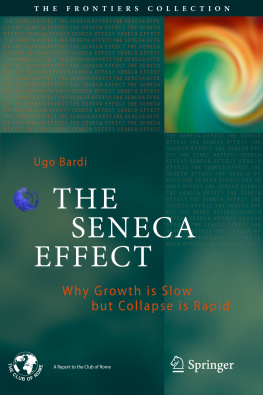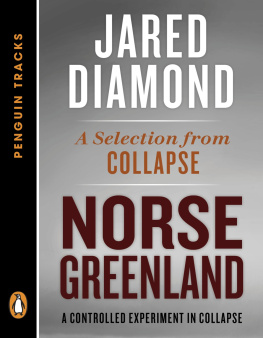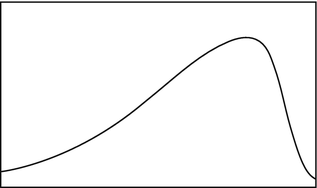1. Introduction: Collapse Is Not a Bug, It Is a Feature
Esset aliquod inbecillitatis nostrae solacium rerumque nostrarum si tam tarde perirent cuncta quam fiunt: nunc incrementa lente exeunt, festinatur in damnum. Lucius Anneaus Seneca (4 BCE-65 CE), Epistolarum Moralium ad Lucilius, n. 91, 6
It would be some consolation for the feebleness of our selves and our works if all things should perish as slowly as they come into being; but as it is, increases are of sluggish growth, but the way to ruin is rapid. Lucius Anneaus Seneca (4 BCE-65 CE), Letters to Lucilius, n. 91, 6 (translated by Richard Gummere)
This is a book dedicated to the phenomenon we call collapse and that we normally associate with catastrophes, disasters, failures, and all sorts of adverse effects. But this is not a catastrophistic book as there are many, nowadays, and it doesnt tell you of the unavoidable doom and gloom to come. Rather, it deals with the science of collapse, explaining why and how collapses occur. If you know what collapses are, then they dont have to come as surprises, they are preventable. You can cope with them, reduce the damage they cause, and even exploit them for your advantage. In the universe, collapse is not a bug , it is a feature (Fig. ).
Fig. 1.1
The Seneca Effect as modeled using the method known as system dynamics . This curve is very general and describes many kinds of physical phenomena that grow slowly and decline rapidly. The term Seneca Effect is inspired by the ancient Roman philosopher, Lucius Annaeus Seneca
So, this book explains what causes collapses, how they unfold, and what are their consequences. That may be useful in various ways: sometimes you want to avoid collapses; then you will develop resilience to avoid the kind of sudden changes that cause a lot of damage to people and things. But, sometimes, you may well want something old and obsolete to collapse, leaving space for something better. If the old never disappeared, there would never be anything new in the world!
Collapses turn out to be varied and ubiquitous phenomena , their causes are multiple, the way they unfold is different, they may be preventable or not, dangerous or not, disastrous or not. They seem to be a manifestation of the tendency of the universe to increase its entropy and to increase it as fast as possible, a principle known as maximum entropy production (MEP) []. So, all collapses share some common characteristics. They are always collective phenomena, meaning that they can only occur in those systems that we call complex, networked systems formed of nodes connected to each other by means of links . A collapse, then, is the rapid rearrangement of a large number of links, including their breakdown and disappearance. So, the things that collapse (everyday objects, towers, planes, ecosystems, companies, empires, or what have you) are always networks. Sometimes the nodes are atoms and the links are chemical bonds; thats the case with solid materials. Sometimes the nodes are physical links between elements of artificial structures, that is one of the subjects of study for engineers. And sometimes the nodes are human beings or social groups and the links are to be found on the Web or in person-to-person communication, or maybe in terms of monetary exchanges. This is the field of study of social sciences, economics, and history.
All these systems have many things in common, the main one is that they behave in a non-linear way. In other words, they dont react proportionally to the intensity of an external perturbation (called forcing in the jargon of the field). In a complex system, there is no simple relationship between cause and effect. Rather, a complex system may multiply the effect of the perturbation many times, as when you scratch a match against a rough surface. Or, the effect may be to dampen it in such a way to be scarcely affected by it, as when you drop a lighted match into a glass of water. This phenomenon of non-linearity of the reaction is often called feedback , an all-important characteristic of complex systems. We speak of enhancing, amplifying, or positive feedback when the system amplifies an external perturbation. We speak of damping, stabilizing, or negative feedback when the system dampens the perturbation and mostly ignores it. Complex systems, it has been said, always kick back [], sometimes they kick back with a vengeance and, at times, they just do what they damn well please.
One way to look at the tendency of complex systems to collapse is in terms of tipping points . This concept indicates that collapse is not a smooth transition; it is a drastic change that takes the system from one state to another, going briefly through an unstable state. This concept was discussed, among others, by Malcolm Gladwell in his 2009 book, The Tipping Point []. In the science of complex systems, the concept of tipping points goes together with that of attractor. (sometimes strange attractor, a term made famous by the first movie of the Jurassic Park series). An attractor is a set of parameters that the system has a certain propensity to reach. The tipping point is the opposite of the attractor in systemic terms: the attractor attracts the system; the tipping point repels it. A system in the condition called homeostasis tends to dance around an attractor, staying close to it but never reaching it. But, if the system moves far enough from the attractor, for instance because of an external perturbation, it may reach the tipping point and fall on the other side, toward a different attractor. In physics, this drastic change is called phase transition and it the basic mechanism of the phenomenon we call collapse.
The capability of a system to maintain itself near an attractor and away from the tipping point, even in the presence of a strong perturbation, is what we call resilience, a term that may be applied in a wide variety of fields, from materials science to social systems. In studying resilience, one quickly discovers that the idea of sticking as close as possible to the attractor may not be so good. A rigid system may be the one that collapses all of a sudden and disastrously, as a piece of glassware that shatters. On this point, we may be reminded of a piece of wisdom that comes from another ancient philosopher, Lao Tsu in his Tao Te Ching , hard and rigid are associated with death. Soft and tender affirm greater life . Indeed, the Seneca effect is most commonly the result of trying to resist change instead of embracing it. The more you resist change, the more change fights back and, eventually, it overcomes your resistance. Often, it does this suddenly. In the end, it is the result of the second principle of thermodynamics: entropy that does its job.
It is not by chance that philosophers often tell you that you should not be attached to the material things that are part of this difficult and impermanent world that continuously changes. It is good advice and, in the history of philosophy, the school called Stoicism was among the first to adopt this view and to try to put it into practice. Seneca was a member of this school and his thought is permeated with this view. The idea that fortune is slow, but ruin is rapid, is part of the concept. So, when dealing with collapse, we may remember the advice that Epictetus, another master of the Stoic school, Make the best use of what is in your power, and take the rest as it happens .











